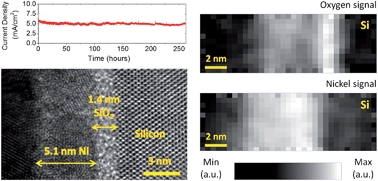Ageing mechanisms of highly active and stable nickel-coated silicon photoanodes for water splitting†
Abstract
The photoelectrochemical (PEC) water splitting cell, a device that uses sunlight to produce hydrogen, has garnered very much interest due to its simple structure, low fabrication cost and good performance. In these cells, a semiconductor photoelectrode is immersed in a liquid and, when illuminated, hydrogen and/or oxygen can be generated on its surface by electrolysis. Metal catalysts are often used to enhance the activity of the semiconductor, but the lifetime of the semiconductor photoelectrode is still the main bottleneck of this technology. In this manuscript we report the ageing mechanisms of silicon photoanodes coated with nickel films of different thicknesses (under the light-driven oxygen evolution reaction, OER). The n-Si photoanodes coated with 2 nm-thick, 5 nm-thick and 10 nm-thick nickel layers showed lifetimes of ∼18 h, ∼150 h and >260 h, respectively. While the 2 nm-thick sample degraded due to the formation of a thin SiOX layer at the metal–silicon interface, the performance of the thicker samples decreased due to the formation of holes. The 5 nm-thick and 10 nm-thick nickel films turned into homogeneous potassium-free NiOX films suitable for water splitting, and this conversion markedly enhanced the performance of the cells. The density/size of holes in the surface decreased/increased with the metal thickness. The potassium contamination in the 2 nm-thick Ni sample took place in the form of nanofilaments, and we demonstrated that the widely used X-ray photoelectron spectroscopy tests are blind to these features, which may have been ignored in all previous reports. These results could be useful for understanding the degradation and enhancing the yield of water-splitting solar cells.


 Please wait while we load your content...
Please wait while we load your content...